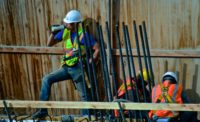A proposed rule from the U.S. Dept. of Labor to broaden its regulation about employee representation on workplace safety inspections has drawn widespread opposition from contractors. The change would allow workers to select a representative employed by a third party. Construction industry groups say that could create liabilities, safety risks and more.
The proposal revives Occupational Safety and Health Administration policy originally implemented in 2013 via a letter of interpretation to the United Steelworkers. OSHA later rescinded it after a lawsuit which argued the regulation should have undergone formal rulemaking. OSHA published its newly proposed rule Aug. 30 in the Federal Register.
In addition to allowing employees to authorize a non-employee as their representative on OSHA inspections, the rule would clarify that third-party representatives are not limited to industrial hygienists and safety engineers. OSHA says the third-party representatives may be used to provide “knowledge, skills or experience with particular hazards or conditions in the workplace or similar workplaces, as well as any relevant language skills a representative may have to facilitate better communication between workers and the [compliance safety and health officer].”
“This proposal aims to make inspections more effective and ultimately make workplaces safer by increasing opportunities for employees to be represented in the inspection process,” said Doug Parker, assistant secretary for OSHA, in a statement.
But the change, as written, would allow open-shop contractors’ employees to choose a union agent or community organizer as their representative, which could cast doubt on OSHA’s status as a neutral enforcer of the law during labor-management disputes, according to a comment on the proposal from the Associated Builders and Contractors. Greg Sizemore, ABC’s vice president of health, safety, environment and workforce development, said in a statement that the proposal lacks clarity in a number of areas, such as how OSHA or an inspector would approve employees’ requests for a third-party representative, or any safety expertise criteria for them.
“There is no restriction on the number of different third-party representatives who may be present for a single inspection, nor on how many employees may request different representatives,” he said.
In its comment on the proposal, the United Brotherhood of Carpenters and Joiners of America said the concerns “are speculative at best,” adding that OSHA inspectors would also have the ability to exclude representatives. However, the union said bringing in a third-party representative could be beneficial in cases where workers’ primary language is not English or when an inspector is not familiar with the many different functions performed by different craft workers on a jobsite.
Other contractor groups shared ABC’s concern. Dozens of industry trade associations, including the Associated General Contractors of America and the American Road and Transportation Builders Association, cosigned comments submitted by the Construction Industry Safety Coalition (CISC) and Coalition for Workplace Safety (CWS) opposing the change. Both coalitions argued the proposal would conflict with the National Labor Relations Act and ignores the rights of employees who have chosen to not have union representation.
Contractors have other concerns. The proposal also is about how employees select a representative, how employers are notified about the choice and what obligations the employer has to the representative, CISC wrote. There is no clarity in the proposal about what types of information a third party could access, what input they could provide or whether they would be able to participate in or influence any settlement discussions.
CISC also said the rule would allow someone to be invited onto a jobsite without any safety qualifications, creating potential liability, particularly if they were injured. They would not necessarily have worker’s compensation coverage, potentially leading them to sue every contractor and subcontractor on site. The proposal also fails to address issues like who would be responsible for the third party’s conduct while on site, and who would be responsible for providing them with safety gear.
“The potential harm to small subcontractors or construction employers is very high,” CISC said in its comment.
The selection of third parties could also violate employers’ property rights by giving someone access to their private workplace and present Fourth Amendment issues if information gained during a visit was used to further a union organizing campaign or gather facts for an employee’s lawsuit, CWS said in its comment. The rule would also weaken employers’ ability to protect trade secrets. And employers would lack any resource to challenge the approval of a third-party representative, the group added.
“The proposed rule would allow third parties with ulterior motives to take advantage of OSHA’s legitimate enforcement processes to further their unrelated interests, which very likely could be hostile to the employer,” CWS wrote.
OSHA's deadline to comment on the proposal was Nov. 13. The agency has not said when it may publish a final rule.






Post a comment to this article
Report Abusive Comment